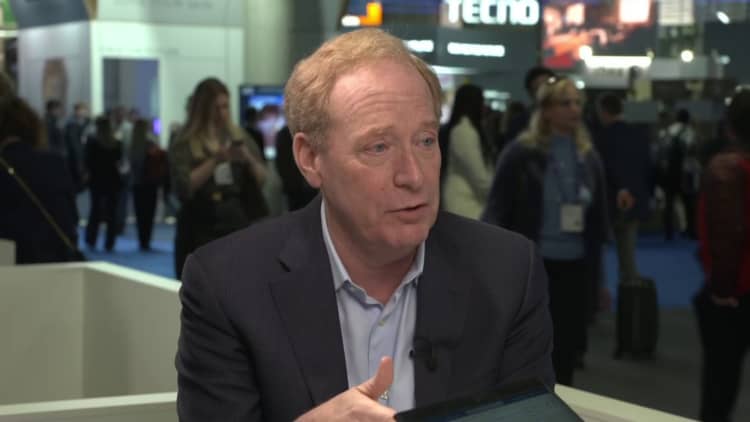
You probably remember mobile operators raving about the promise of 5G several years ago. Now, they’re getting excited about a new upgrade: 5G Advanced.
Angel Garcia | Bloomberg | Getty Images
BARCELONA, Spain — Telecom operators haven’t yet finished rolling out 5G wireless mobile networks. And yet bosses of major carriers are already talking about building something called “5.5G,” or “5G Advanced.”
There was a lot of chatter about 5.5G at the Mobile World Congress tech trade show in Barcelona, Spain.
MWC brought together thousands of people in the mobile industry, including from leading telecom companies like Deutsche Telekom, Orange, Telefonica, BT, and Vodafone.
At the show, executives from some of these companies that they were working toward rolling out a new generation of mobile internet.
That would enable even more advanced applications than the data-intensive apps we’ve all come to use today, such as Facebook, Instagram, YouTube, Netflix, and TikTok.
These apps are already well served by the current mobile internet, but in the future 5.5G is expected to power more advanced applications.

That includes mixed reality headsets, which are getting more and more powerful with tech giants like Apple launching its Apple Vision Pro and Meta upgrading with its Meta Quest Pro headset last year.
But it also means some of the things that 5G promised us years ago, such as self-driving cars, unpiloted air taxis, and smart manufacturing enabled via the so-called internet of things (IoT), will start to become a reality, too.
What is 5G?
5G is the next generation of mobile internet after 4G, which promises superfast data speeds and better coverage.
You probably remember mobile network operators raving about the promise of 5G several years ago. Carriers in China, South Korea, the United States, and Europe, properly got underway with launches of 5G networks in 2019.
Now, nearly five years on, penetration of 5G among consumers remains low.
The number of consumers with a 5G connection is increasing. But it’s still well below “mainstream” levels.
5G has been the fastest mobile generation rollout to date, surpassing 1 billion connections by the end of 2022, rising to 1.6 billion connections at the end of 2023 and 5.5 billion by 2030.
5G connections are expected to represent more than half (51%) of mobile connections by 2029, though, and that is forecast to then rise 56% by 2030. Those numbers are up to date as of January 2024, GSMAi said.

5G has been positioned by the telecoms industry not just as a consumer product for faster download speeds, but as a network that could underpin new technologies like driverless cars or unpiloted air taxis.
That’s because it has lower latency than 4G. That means the time it takes for devices to talk to each other is significantly reduced, a feature important in scenarios where data needs to be delivered quickly.
However, after hundreds of billions of dollars of investment into 5G networks, carriers have struggled to see the return. Analysts say that the real potential to monetize 5G might be on the horizon.
What’s ‘5.5G,’ and why are telcos talking about it?
5G Advanced, or the name for the next stage of 5G, is the next evolution of mobile networks.
Telecommunications networks require standards. These are globally accepted technical rules that define how a technology works and its interoperability around the world — interoperability is the ability for two or more systems to work together.
These standards take several years to come up with and finalize and involve several players from companies to academics and industry bodies.
The standards-setting body 3GPP, which contributed to 5G, uses a system of parallel “releases” to provide developers with a platform to implement new features at a given point and then allow more functionality to come in further releases.
In the 3GPP releases system, 5G is considered release 17. That means 5.5G is dubbed “release 18” by the industry.
Release 19 is what will effectively be 6G, another major network upgrade. Work is also underway on 6G standards, but it’s still in the early stages.

“Main priorities for developing 5G Advanced standards are to increase commercial relevance of 5G by expanding vertical markets, resolve deployment issues, and continue technology evolution to build a bridge towards 6G,” Milind Kulkarni, vice president and head of InterDigital’s wireless labs, told CNBC.
“Research in standards have introduced, improved, and finalized several new enterprise-specific features for 5G Advanced, including network slicing, the integration of private and public networks, enhanced positioning, and even applications specific to each enterprise vertical.”
Howard Watson, the chief technology officer of British telco giant BT, said that 5.5G will promise faster uplink speeds, meaning you’ll be able to stream video, post things online, and play multiplayer games, much faster than before.
“My children’s generation, or even dare I say it, my grandchild’s generation … that generation, they share a lot. And clearly, sharing requires quite a lot of upstream,” Watson told CNBC on the sidelines of MWC. “There will probably be a doubling of upstream capacities coming in release 18.”
Further benefits to 5G Advanced over current 5G, telco execs say, is that it will make the networks themselves more “intelligent” through the application of AI and machine learning, while also boosting performance and reducing overall power consumption.

Mats Granryd, director general of the GSMA, told CNBC he hopes the industry can continue focusing on staying in a 5G environment for years to come, as there’s still plenty of work to be done on monetization.
“I hope that we can stay in 5G territory for long, because normally in the 4G environment, you and I were the consumers. And it’s quite quick for us to just say, change a SIM card,” Granryd told CNBC’s Karen Tso. “In 5G, 5G is a technology standard that is predominantly towards business to business. And it takes a longer time for businesses to convert and use new technology.”
“This normal of 10 years between standards, I wonder if that’s going to be enough,” Granryd added. “We hope that we can stay in a 5G environment. 5G advanced — 5G standalone, that’s absolutely fine. But push out the time and make sure that we have enough mileage to capitalize and monetize and show the world that 5G is a fantastic technology.”
With 5G Advanced, telecoms firms could start to make more money from their 5G rollouts by charging higher prices. And, with a key focus of 5G being enterprise applications, that could be a much more significant money maker for network operators than consumers.
Telcos haven’t yet revealed how much more a 5G Advanced data plan will cost compared with 5G. But analysts expect they’ll look to make money from 5G Advanced by getting clever about subscriptions and using AI and other technologies to operate their networks more efficiently.
With a key focus of 5G being enterprise applications, that could be a much more significant money maker for network operators than consumers.
The telco industry has been awash with talk about so-called “private 5G” networks, nonpublic mobile networks that are installed on-premise at companies’ work sites for example, in a smart factory, or remote surgery operation.
When will 5G Advanced be here?
Chinese telecommunications equipment supplier Huawei expects 2024 to be the year that commercial deployments of 5G Advanced officially begin. For Huawei, 5.5G is a network that will be capable of 10 Gbps downlink speeds — and in case you’re wondering, yes, that is very fast.

Huawei revealed eight 5.5G “innovation practices” last week which it says will help operators build 5.5G networks across all frequency bands. The company is working with carriers in the Middle East, Europe, Asia Pacific, and Latin America to deploy 5.5G.
It’s going to take some convincing for consumers to go from 5G to 5G Advanced, given the little noticeable improvement they’ve seen from their phones upgrading to 5G in the past five years. But Philip Song, Huawei’s chief marketing officer of the carrier business group, said that it’s important telcos convey the use cases of 5G Advanced to consumers well.
“The most important thing for us is how can we support the customers,” he said at a press briefing last Tuesday, in response to a CNBC question. The “biggest success” for 5.5G will only arrive if carriers “acknowledge solutions” and bring that across to customers sufficiently.
In some markets, operators are still working on deploying 4G, Song said — but he doesn’t think that matters because different parts of the world “are at different stages.”
Watson told CNBC that he thinks 5G Advanced will arrive on the EE network later this year. That’s because the 3GPP standard release 18, or 5.5G, is already open for experimentation and telcos have been working on trials. It is expected to conclude by June 2024, by which time the protocols that enable 5.5G should be stable.
“Release 18 we will start to roll out this year,” Watson told CNBC. “We also plan to launch 5G standalone this year as well.”

5G standalone is different from 5G Advanced. Sometimes referred to as “true” 5G, it refers to the development of a 5G network that uses technology independent of 4G and comes with the promise of realizing 5G’s full potential.
5G Advanced, on the other hand, is a complete evolution of the network.
There’s no definitive date for when 5G Advanced will start to be rolled out, though. And telcos are on the clock to get it up and running.
“I hope that we will be at the bandwidth, the latency, the capability needs to be sufficient,” Mats Granryd, director general of the GSMA, told CNBC’s Karen Tso at MWC last week.
“That’s what we’re struggling with to see in Europe. In five years, we’re going to have a quadrupling of data usage. And I am really concerned about what’s going to happen at that stage.”
“Will we have cut-offs? Will we have congestions?” he added. “Will we have a much much worse situation, a much worse landscape? By having that worse landscape, the competitiveness of Europe will go down.”
— CNBC’s Arjun Kharpal contributed to this report
